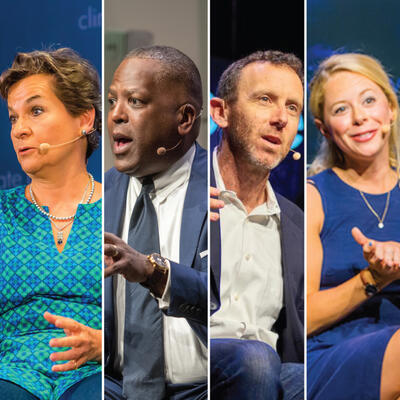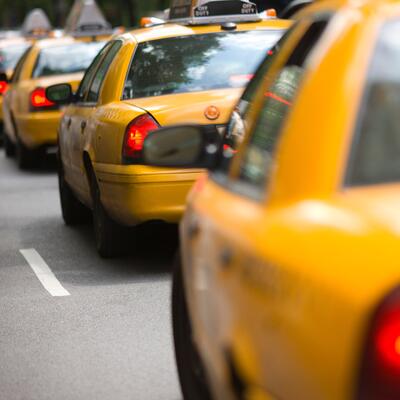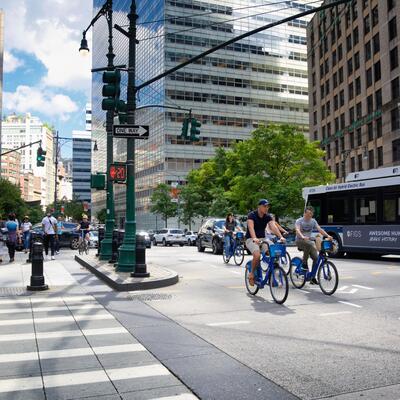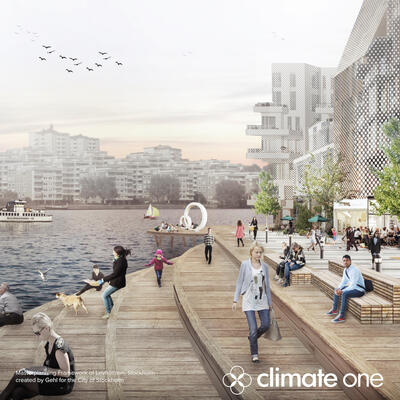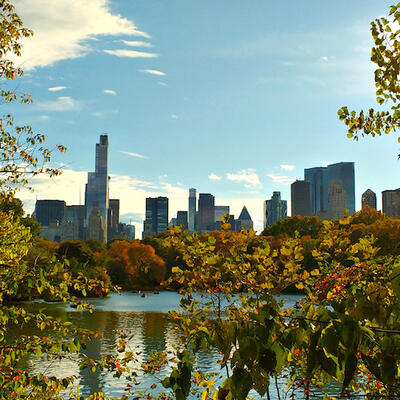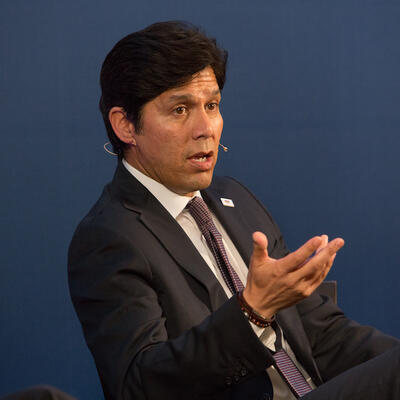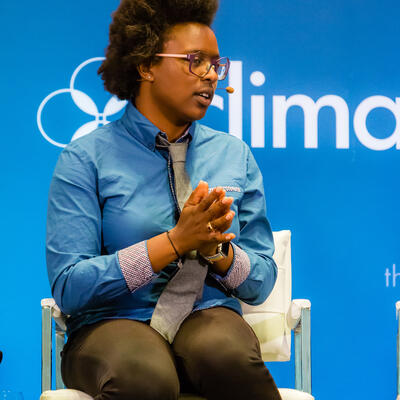
New Wheels in Town
Guests
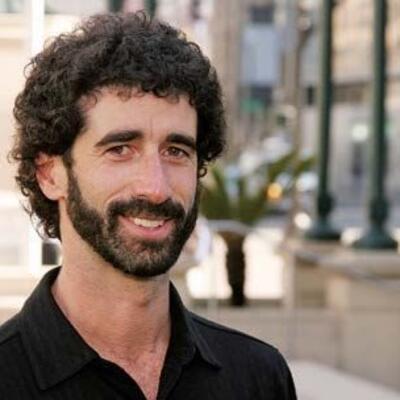
Stuart Cohen

Sanjay Dastoor

Megan Rose Dickey
Summary
Electric scooters, skateboards and bicycles are popping up all over in cities all over the country. Ride-hailing companies are also moving to two wheels. Uber bought the bike sharing company Jump, and Lyft followed suit by scooping up Motivate, which operates bike sharing services in San Francisco, Boston, Chicago, New York and other cities. Is an electric skateboard company next? As companies jockey to offer a suite of transportation options what is the future of urban mobility? Are these new urban toys really solving the notorious first-mile and last-mile problem?
This program was recorded live at The Commonwealth Club in San Francisco on June 20, 2018.
Full Transcript
Announcer: This is Climate One, changing the conversation about energy, economy and the environment.
Over the last few years, getting around in some cities has gotten a lot more flexible and accessible.
Sanjay Dastoor: It’s electric skateboards, it’s electric scooters, it’s electric bicycles
Megan Rose Dickey: Green scooters, black scooters, orange scooters
Sanjay Dastoor: Cargo bicycles that have three wheels and kids being taken to school
Megan Rose Dickey: There’s docked and there’s dockless
Sanjay Dastoor: 30% 35%, 40% of commutes happening by bicycle.
Announcer: But does more traffic in the bike lane mean a fundamental change in urban mobility?
Stuart Cohen: What is a game changer is just the profusion of choices that we increasingly have. People don't have to think about where's my car keys. They just have to think about choosing between affordability, how quick it is, how comfortable, or with scooters or bike shares how fun it is.
Announcer: New wheels in town. Up next on Climate One.
Announcer: What’s the most fun, affordable, and energy-efficient way to get around town? Welcome to Climate One – changing the conversation about energy, economy and the environment. Climate One conversations – with oil companies and environmentalists, Republicans and Democrats – are recorded before a live audience, and hosted by Greg Dalton.
I’m Devon Strolovitch. Electric scooters, skateboards, and bicycles are suddenly sprouting on sidewalks and in parking spaces all around the country. If you haven’t seen them yet where you live, you might soon. In 2017 the number of shared bikes doubled to 100,000 nationwide and investors are pouring money into more than 30 startup companies deploying bikes and scooters around commercial and residential neighborhoods.
Sanjay Dastoor: Anything that makes transportation more affordable, more accessible, more equitable potentially is worth a lot.
Announcer: Sanjay Dastoor is cofounder of Boosted Boards and CEO of Skip Scooters, two of those new mobility companies. But some older startups are also getting into the bike and scooter game.
Megan Rose Dickey: If you open the Uber app, they want to have ride hailing, they want to have bike share and they want to have electric scooters.
Announcer: That’s Megan Rose Dickey, a senior reporter with TechCrunch. Uber’s business model famously caught officials in many cities off-guard. The newer mobility companies are facing stricter requirements as they deploy around the country.
Stuart Cohen: Regulators are quickly coming up to speed on, oh yeah, we kind of control the streets, we can ask for things meet our equity in climate and other goals.
Announcer: Stuart Cohen is Executive Director of TransForm, a transit advocacy group. He joined host Greg Dalton, along with Megan Rose Dickey and Sanjay Dastoor, at a recent Climate One event to discuss the new urban mobility.
Greg Dalton: Sanjay, let’s begin with you. Seven years ago, you started Boosted Boards. What was your inspiration, your goal, starting a skateboards company?
Sanjay Dastoor: Yeah, it was an odd choice because I'd never skateboarded before. But we were, a group of us were in graduate school at Stanford. Stanford is a very spread out campus and Palo Alto as a city is a little bit far from campus for walking. And so the Boosted Boards was kind of a fun thing we built for ourselves to be able to get around the campus and cover these short trips in between buildings or parking lots or be able to take it on to the Caltrain system the transit system in the Bay Area and be able to cover these short distances. And what we found was that people liked it because it was interesting and cool. But then after they started to use it they said wow, this actually changed the way that I get around my city.
Greg Dalton: So it started, yeah, like classic story of a Silicon Valley entrepreneur, you know, solving a problem in their life and starting a company to address that. Megan Rose Dickey, where is this happening, give us a sense of the geographic scope of these scooters and bikes that are popping up.
Megan Rose Dickey: Yeah I mean it's worldwide, especially with bike share. We see bike share in China like that’s where were it really kind of took off. And then with these electric scooters we’re seeing them all across the nation in San Francisco, in Austin, Texas in Santa Monica, California, Venice, California, Washington DC. There are some in North Carolina they’re kind of just popping up all over the state and even Lime for example, they have some scooters over in Switzerland.
Greg Dalton: And the rollout how these things have appeared has had a big impact and how they’ve been received by citizens. So Megan tell us how they rolled out in San Francisco and how that compares to the rollout in other cities. Because there’s been quite a difference in the way they kind of shown up.
Megan Rose Dickey: Yeah, it wasn’t great the way that they rolled out in San Francisco. And a lot of city regulators were pretty upset with Bird, Lime and Spin. And so they just deployed on the streets. Next thing you know people are on like green scooters, black scooters, orange scooters just all on the sidewalks. It prompted a few things from the city of San Francisco. One was a cease-and-desist letter from the city attorney that held zero weight whatsoever and they just kind of stayed on the streets. But it later resulted in a permitting process. So similar to what San Francisco did around bike share, one of San Francisco’s legislative bodies then worked with some city legislators to develop a permitting process to ensure that scooters weren't totally gonna ruin the city and make things super complicated.
Greg Dalton: Sanjay, you came out and rolled out in a different way in Washington DC, little smoother. Tell us about how that rollout happened.
Sanjay Dastoor: Yeah, so we’re actually based in San Francisco. So our first choice to launch was here. But we knew that based on how bike share had rolled out in San Francisco there would be a permitting process. So we chose to work with a city on creating a permanent launching with their permission first. Washington DC already had a permitting process for dockless bike share. So they already created this process and we were able to work with the DOT, the Department of Transportation locally in Washington DC to create kind of a sub permit for dockless scooters and be the first to launch there in February.
Greg Dalton: So did you just say functioning government in Washington DC?
Sanjay Dastoor: Yeah. Local government.
Greg Dalton: City government. Okay, okay. So Stuart Cohen, where does this add up, is this gonna, you know, last mile, first mile has been a vexing problem in transportation for a long time getting to and from a train or a bus. Is this a game changer?
Stuart Cohen: I think we still have to wait to see whether it’s a game changer. I think what is a game changer is just the profusion of choices that we increasingly have. Add this on to bike share. Add this on to Uber, Lyft, including their shared services chariot. There’s all of these other, you know, shuttles that are starting having all of those and essentially once they become either all-in-one app or just very easy to organize brings to what you said mobility as a service. When people don't have to think about where's my car keys. They just have to think about what are my best options for getting there. You know choosing between affordability how quick it is how comfortable or with scooters or bike shares how fun it is.
Greg Dalton: Megan Rose Dickey, for those who haven't had the experience explain for us there is docked bike share and there is dockless. So explain to us the experience for people who’ve kind of seen it, but actually haven't done it.
Megan Rose Dickey: Okay. So a bike share –
Greg Dalton: Just bike share.
Megan Rose Dickey: Yeah, so on one hand there's docked. And I’m gonna use the example of San Francisco just because I live here. So on one hand there’s docked. So those are the Ford GoBikes they, essentially there are these like stands of maybe like ten or so bikes. And you go up to the little kiosk you get your bike and then you return it at some other kiosk like throughout the city.
Greg Dalton: You can pay by credit card for a single trip or have a monthly subscription.
Megan Rose Dickey: Right you can have monthly subscription if you like. And then there’s dockless and there’s a couple of different forms of dockless. So there’s locked to which means that you actually lock the bike to a physical structure like a bike rack. It can be any old bike rack or can be a pole. And then there's also more like free floating dockless where it just, the bike just kind of locks to itself. In San Francisco we have locked to bikes and that's via Jump bikes, which is now owned by Uber.
Greg Dalton: And these exist all over. I've used them in Ottawa, Canada, Washington DC, and you can go as a tourist and do this all over. Sanjay explain for us now scooters. Scooters usually are not docked they're all over the place. So what's it like you just walk up and what do you do?
Sanjay Dastoor: Yeah, so scooters kind of passed the docked phase and went straight into dockless and free-floating. So the history of bike share was that you have this kiosk and the kiosk would, the bike would be physically attached to the kiosk you need to unlock it to remove it. And so it, you know, removes issues like theft and parking. The downside is that you have to find the next kiosk to drop it off at. So if you’re thinking about your trip you've got the time to walk to the nearest dock. The time you’d spend kind of unlocking the bike and getting it set up, adjusting the seat height. The times you spend riding and the time you spend potentially getting to the next dock and finding that it’s full.
Greg Dalton: That happens yeah.
Sanjay Dastoor: You have to go to the next one. And so there's this rebalancing problem you have to move the bikes between kiosks to make sure that you got enough but not too many at any given dock. The way that the scooters are working is similar to how dockless bike shares worked in China, which is that you simply walk up and using a smartphone you use the camera to scan a code or to type in a code on your phone and that vehicle is actually connected to the Internet all the time. And so it connects, the server gets a signal and unlocks and now you can ride it. And then when you get to your destination you use your phone again to simply lock it. And so it could be free-floating, which means that it's not connected to anything and could be in the way or it could be locked to in which case it's hopefully against the pole or bike rack.
Greg Dalton: We sent someone on the streets of San Francisco to get a reaction to this new collision of scooters and pedestrians. Let’s hear.
Male Speaker: I bought one of these scooters recently. It’s pretty cool. This is a Xiaomi scooter, electric scooter. Yeah, it’s pretty awesome they’re all over the city recently. But then the city took them down so I just bought mine and it’s pretty convenient if you’re like a mile or so kind of distance.
Male Speaker: I walk a lot all over. I hate scooters on the sidewalks, riding on the sidewalks as bad as I hate bicycles and skateboards.
Male Speaker: I think this is a godsend. I think this is very convenient using these bikes to get to work. I used to be a part of the city bike share before I bought them. And I’m like well I continue to use it. I actually might buy my own electric bike one day. I’m sold on it.
Female Speaker: Unfortunately I’m not a big fan of none of those. The skateboard is the worst, you know, they just zigzag through the street is really dangerous, you know.
Male Speaker: I’m saving up for an electric bike right now because it’s easier to get around. I haven’t own a car like 30 years.
Female Speaker: I wanted to go a little faster than people walking. I did feel like people were in my way and I don’t know, some people seem like they would step out right in front of me and I’m just like come on, are you doing this on purpose?
Male Speaker: I think if everybody was riding scooters in the city, it’ll probably be a lot nicer. That being said, if it’s like there’s scooters and bikes and skateboards and people on all that sort of stuff then it’s like it becomes very challenging.
Greg Dalton: Voices from the streets of San Francisco. Sanjay Dastoor, your reaction to that. Love them, hate them, hurry up, get out of the way.
Sanjay Dastoor: Well I think a lot of it comes down to user behavior and not just the vehicle itself. I mean we have reckless drivers and we have safe drivers. We have people who double parked their cars, you know, park them on sidewalks block pedestrian access with their car just as much as we do with these vehicles. And so I think a lot of it –
Greg Dalton: And we don't blame the cars we blame the driver.
Sanjay Dastoor: Exactly. And so I think, you know, having access to these vehicles can bring out both the best and the worst in someone when they think about how they're impacting the people around them. I think a lot of the conversation has been about the riders and about the businesses. I think there’s another conversation to be had around the people who don't ride. So if you think about the folks who are, you know, these scooters or bikes or other vehicles are in their way how does this work with them. But I think a lot comes down education, proper etiquette advocacy and actually building systems that work well. So for example, in Washington DC the reason we didn't make the news there is because there hasn't been this kind of backlash, right. We actually worked with the city we worked with the National Park Service. We work with the different police departments we work with citizen groups in DC. And so we created a very formal and structured rollout process where there is a way for people to make sure that we were doing our job. And as a result, we haven't been in the news there because it’s actually is working great.
Greg Dalton: Megan let’s get your take on what you heard from the people on the street in this kind of this new culture evolving very quickly.
Megan Rose Dickey: Yeah. I mean I think two of the biggest issues around this influx of electric scooters in cities is one, them being on sidewalks. So not only is it frustrating for pedestrians who are able-bodied but think about people who are in wheelchairs. And then next thing you know there’s a scooter in the middle of the sidewalk like it doesn't, it's easier to navigate that if you're able-bodied, but not so much if you're in a wheelchair. And so like that space needs to be clear in order to really like have sidewalks be accessible to everyone. And then the second thing is around people not wearing helmets. So companies have said oh well we encourage our riders to wear helmets but at the end of the day you can't. It's hard to actually force someone to put on a helmet. And some companies are saying oh well we’ll let people like pickup helmets like at our office or et cetera. But I think it's hard to incentivize people to always do the right thing and the safe thing.
Greg Dalton: And Sanjay are helmets kind of a deterrent they’re kind of like another piece of paraphernalia that’s like takes away a little bit of the joy complicates the experience.
Sanjay Dastoor: Well yeah, if you look at cities that have very strong biking populations. If you look at places like Amsterdam or Copenhagen. You know they have 30% 35%, 40% of commutes happening by bicycle. Most people there don't wear helmets. And actually not requiring a helmet in those places is partially because there’s great infrastructure that was built in those cities to support bicyclists that separate from the way that cars are treated in the speed which cars are going next to the bicycles. And partially it’s because helmet usage, you know, adds more friction and one more thing to do. I think for shared systems to succeed if you look at Citi Bike in New York, for example, you know they don't require helmets, that program has been very successful Ford GoBike here in San Francisco. So I think the future eventually is fewer people will be using helmets than will be. But I think it’s important to have access to those helmets. So that if someone wants to be safer they have the opportunity to do so.
Greg Dalton: Stuart Cohen, you know, is this the case of, you know, nanny government, should government regulate safety in this place, or should it kind of like provide a safe place, but don't regulate helmets.
Stuart Cohen: Well, I think government should push safety. But I do think the main danger out there continues to be vehicles and vehicle collisions with people. And so I think Sanjay is right that when we hear about all these people complaining about it being on the sidewalk let’s take that energy and create more space on our streets for shared vehicles and for these sustainable modes of bikes and scooters. I think the scooters, you know, you have to go pretty slow on the sidewalk even if you are weaving between people. So to me it's really a call with all of these new options to get more separated infrastructure for bikes for scooters for things. And I think you're right like with bike share it's gonna go ahead with encouragement for helmets, but I just don't see us getting to hundred percent helmet use on this.
Announcer: You’re listening to a Climate One conversation about new ways of getting around town. Coming up, Greg Dalton asks about the greenhouse gas impact of these new wheels, and how to get more people using them.
Stuart Cohen: To encourage these more sustainable modes we need to really rethink how transportation happens and if we’re gonna have real sharing of we've got to be giving them priority.
Announcer: That’s up next, when Climate One continues.
Announcer: We continue now with Climate One. Greg Dalton is talking about the new urban mobility with Megan Rose Dickey, a senior reporter with TechCrunch; Stuart Cohen, Executive Director of TransForm, a transit advocacy group; and Sanjay Dastoor, cofounder of Boosted Boards and CEO of Skip Scooters.
Here’s your host, Greg Dalton.
Greg Dalton: Megan Rose Dickey, why are Uber and Lyft getting into this. What’s in it for them?
Megan Rose Dickey: They’re greedy they want everything. But really I mean that’s it. They, I mean Uber’s not new-ish CEO, Dara Khosrowshahi has said that Uber wants to become this multimodal transportation platform. Meaning if you open the Uber app, they want to have ride hailing, they want to have bike share and they want to have electric scooters. They want to have aerial taxis like they want it all the public transit, to eat.
Greg Dalton: Deliver a pizza.
Megan Rose Dickey: I forget exactly if Uber announced or either way both Uber and Lyft are looking into electric scooters as well as bike share. And yeah like I said they just want to own transportation.
Greg Dalton: So that whether it's a one-mile thing or a 5-mile thing, airport run or hop downtown they want Uber to be or Lyft to be the place you go to do that. Stuart Cohen, what do we know about Uber and Lyft in terms of what they're taking people out of, you know, to get into their cars. Are they coming out of transit where are they coming from?
Stuart Cohen: Yeah, well there’s been growing number of studies, but I think one of the best ones came out of UC Davis recently where they were actually able to really interview folks in seven of the largest cities. And found that a good number of the trips they put it at 49% to 61% were coming out of either walking, biking, transit or a trip that went to made at all, about 20% of those went to been made at all. And so the other portion then are replacing, you know, drive alone or carpool trips. And so they also said that, you know, there's some amount of deadheading, its range between 20% to 50% that's when they're driving looking for somebody so kind of putting on miles. And so that report said that you can't really nail down how much extra miles of travel are happening but that directionally were pretty sure that they’re increasing the number of miles being driven on our roads. What we need to do to change that is that right now, you know, you pull up your app and it's just so convenient both Lyft and Uber to just go with that single ride. I know Lyft at least has started to change their app so that it will encourage shared rides, including just showing you how much less expensive it is and kind of giving you a guaranteed time. And then they would be putting on, you know, bikeshare, scooter onto that. And so the benefit in some ways of having Lyft and Uber get into this is that you get to see less expensive, more sustainable modes stacked up against what's currently something that might be increasing the amount of driving that’s taking place.
Greg Dalton: So that gets to the greenhouse gas impact which ultimately is what we are concerned about here at Climate One, you know, we know that Uber and Lyft they’re increasing the number the amount of congestion cars on the road and so are you saying Stuart Cohen that having scooters versus well is that one-mile, you know, I could hop on a scooter and go there for a dollar and maybe they’ll show me the greenhouse impact the carbon emissions. Or take a car and it'll – is that where we’re going?
Stuart Cohen: I think it is. Large number of those trips are under 3 miles. And that's where the bike sharing scooters can really come into play. And so, you know, one of the Lyft, Uber trips is $7 in that range, you know, $6 to $7 and the bikes are, you know, $1 to $2. That’s a very big price difference. And, you know, the speed might not be all that different as well especially in downtown of course might be faster. The ultimate thing is really also showing how far it would take to walk. Because a lot of trips are 1 to 2 miles and, you know, by time you wait by the time you sit at the lights, you could do that walk in 25 minutes and that's the most sustainable way to go. But to encourage that to encourage these more sustainable modes we need to really rethink how transportation happens and to get if we’re gonna have real sharing of vehicles whether it's on transit or in, you know, Lyft and other modes that we've got to be giving them priority and that’s a whole separate issue.
Greg Dalton: Megan Rose Dickey, transportation is a big sometimes number two expense for some people after housing. Is scooters and bikes kind of making mobility more affordable and accessible for low-income communities?
Megan Rose Dickey: I would definitely say more affordable but accessibility kind of depends on the company itself. And like one example so with Jump bikes which sold to Uber, they first launched in a low-income area in the city of San Francisco to just to kind of more deliberately say like, hey we want to make sure that this is accessible to low income people from the get-go. And then once we know that that's going to work there then we'll kind of broaden out the like the pilot program essentially. And that is part of the requirement for San Francisco’s permitting process to show okay how are you gonna make sure that your that this form of transportation is accessible to underserved communities.
Greg Dalton: Sanjay, why is this happening now? I mean there was the Segway 15 years ago, Razor, how many kids have had Razors, scooter’s been around forever. Why this sudden proliferation now what’s enabling this?
Sanjay Dastoor: Yeah, it's a few things. So I think there's broadly this push towards the bike lane being a way to solve a lot of the transportation needs, especially the density or a campus or a dense neighborhood. And I think a lot of that comes from whether the car lane is serving us better over time, or worse. And I think there's a lot of evidence that suggest that the car lane is less and less of the best solution for certain types of trips, especially in cities. And as cities get more dense and as, you know, e-commerce delivery trucks are blocking lanes or as Lyft and Uber cars are pulling over there's a sense of well is the car lane really the fastest, most effective way to get around. And so the bike lane has seen a growth in popularity. So if you look at the even long-standing programs like Citi Bike in New York using ridership grow and the popular to the program increase. And then separately there's a technology component to this. Now everyone has a smart phone, they can hail a car just, you know, by pushing a few buttons on that phone. You can embed those same phone components into a vehicle for very low cost. And now these vehicles can have GPS, they can have sensors to detect if they fallen over or not. They have full time, you know, SIM card, cellular connection to the Internet that's all been brought about by smartphones. And so if you look at the cost of building something comparable to the Segway from 15 years ago in performance it’s much less expensive today. And then it's also being used in a way where people feel oh this is actually a better solution for me than the car that I used to use.
Greg Dalton: Okay. Stuart Cohen, how big of a transformation is this gonna be in transportation. I’d like to also connect it to autonomous vehicles. You know that same technological change that Sanjay just described is coming toward vehicles and there's a lot of hype and excitement about autonomous connected electric and shared vehicles. Are the scooters a precursor of what we’re gonna see in cars?
Stuart Cohen: I don’t know if there are precursor, you know, I think the closest precursor is kind of the Lyft, Uber model because increasingly it seems like the first autonomous vehicles that we’ll all get to experience will be fleet vehicles and –
Greg Dalton: They’ll be too expensive to buy.
Stuart Cohen: They’ll be too expensive to buy. Waymo, which is the Google alphabet company had been kind of leaning towards, you know, supporting production and recently announced that they’re gonna be buying their own fleet for fleet vehicles and that of course is where Uber and Lyft are going. So it's gonna be profound I think a lot of us in the planning profession a lot of regulators are really unprepared. There's now suddenly over the last few years this profusion of conferences and papers about will it be Armageddon, you know, awful or will it be paradise. But I think if we don't act it is gonna be awful. And so what it could look like is a lot more driving on our streets because it's going to become so much easier, more competitive, you know, the price of being in an autonomous fleet vehicle will be much lower than the current Uber, Lyft model and it will become very attractive. And so we’re gonna even more so need to really prioritize those trips that are made in a shared way. But we can have, you know, we've been trying to get rid of single occupant vehicle trips and now there's this whole specter of zero occupant vehicle trips becoming a large part of our transportation system.
Greg Dalton: Zombie cars. If you’re just joining us we’re talking about new mobility in American cities with Stuart Cohen from TransForm a transit advocacy group Sanjay Dastoor, cofounder of Boosted Boards, and Megan Rose Dickey, Senior Reporter at TechCrunch, I'm Greg Dalton. Megan Rose Dickey, there's a lot more money on the -- it's gonna be paradise side of that equation then there is it’s gonna be Armageddon side. There’s a lot of companies that have a financial stake and selling us that rosy picture of autonomous vehicles because they get to sell lots of fancy stuff to, right, versus, oh it’s gonna be zombie car gridlock, right. There’s not a lot of money pushing that. So comment on that because you covered the hype machine in Silicon Valley.
Megan Rose Dickey: Yeah. I think the opportunity with autonomous vehicles is that if you think of Uber and Lyft right now the cars are driven by like regular good old-fashioned humans. And they are incentivized to be out on the road to always be looking for those fares. So I think in an ideal sort of world and maybe like what these companies are envisioning is that if there are also autonomous vehicles, then they'll know like they’ll just drive themselves back to the factory or the depot or whatever. They’re not just going to be like driving around like waiting to get that ding like they’ll actually, hopefully, stop driving, get off the street. And then if they get pinged then go back out.
Greg Dalton: Sanjay Dastoor, you know, the reason those Uber and Lyft drivers are all incented to be out there it's all about that low response time. I want that car within a minute or two I'm not waiting for where is it. And to have that they got to be ubiquitous and everywhere.
Sanjay Dastoor: They do and you have to have more of them than you need to account for the fact that, you know, at 8:45 in the morning to make that 9:00 meeting everyone's trying to go get in that car or they’ll go to lunch or to come back from lunch. And so you have to have supply and demand match and that can often mean excess supply. And so as cities try to cope with more trips and more miles driven with these vehicles and there's a limited number of lanes in roads. It doesn't matter if 10% or 20% of autonomous you’re still sitting in traffic at a red light that was never designed for that volume of cars. So I actually think the bike lane, I think scooters are gonna be a massive part of this are a much better solution. And the more people we can get out of cars, these trips whether it's into transit, whether it’s into the bike lane or whether it's walking the better off our cities are gonna be.
Greg Dalton: So let's talk about that bike lane because I cycle a fair amount. And I’m not so hot on those scooters in that bike lane. So, but then people don’t want them on the sidewalks either. So are bicycles and scooters gonna happily coexist and they are bike lanes.
Sanjay Dastoor: They are, they are. And I think but if you look at what's actually even allowed in them, and has been for a long time it’s electric skateboards, it’s electric scooters it’s electric bicycles, it’s cargo bicycles that have three wheels and kids being taken to school, it’s wheelchairs, mobility devices. And so I think generally what regulators have proposed they said if we put a cap on the speed of let's say 20 or 25 mph. We put a cap on the power level. We put a cap on the weight of these vehicles, we can’t obviously put like a 2-ton vehicle on the bike lane. But if you can, you know, put a cargo bicycles that have three wheels and kids being taken to school that’s a perfectly normal use even if it's electrically assisted. And so what I suspect will happen is that lane will move from just being pedal bicycles to a variety of small, lightweight vehicles, probably with some kind of electric assist that are much more efficient have much less of a footprint. And there's plenty of cases, especially in countries and cities that have invested in infrastructure or even in San Francisco if you look at the Embarcadero, which is right outside this beautiful wide multi-use path has pedestrians and cyclists and scooter riders and skateboard riders happily coexisting because it's a wide space. And the history of our cities has been to shrink that space and then make the sidewalk narrow and narrow and space of more car lanes and more parking spaces. And I think what’s gonna happen, hopefully, is that those parking spaces and car lanes actually give way to more multi-use space that’s more efficient.
Greg Dalton: Let's talk about data because data is key to all of this. Megan Rose Dickey, when Uber and Lyft came on the scene regulators were playing catch-up and they didn't really get the data out of those companies. Now with scooters, you know, what are we learning from bike share scooters is probably really early but tell us what the data is telling us in terms of, you know, the social patterns the commute patterns people using these new tools.
Megan Rose Dickey: Yeah so I mean what cities like San Francisco are looking for from these scooter companies is information around trip data. Because essentially the pilot program that the city of San Francisco is doing is its purpose is to see if electric scooters can actually work in the city and actually like maybe reduce traffic or like, you know, like by getting more people in scooters and fewer people in cars. So that's why they need that trip data to really see how it kind of compares to a world without the electric scooters versus a world with them.
Greg Dalton: And Stuart Cohen that didn't happen so much with Uber and Lyft because the regulators didn't make handing over the data a condition of getting a permit and like a genie without a bottle. Is that being addressed this time or it’s like, oh, you know, you want a permit give us your data, you’ll get your permit.
Stuart Cohen: It is. It’s been interesting to watch the evolution. You know, regulators were caught off guard early on by these new business models. But the permit application for the scooters is really fascinating because San Francisco has had time to kind of create a whole new mobility framework, they’re requiring everything from data sharing to outreach in multiple languages to low income discounts. There's about 40 very prescriptive items to be able to apply for this permit and at the end of the day you might get 250 scooters at first or 500. So the fact that 12 of these applications went in so quickly even though it was so prescriptive really just shows two things. It shows how much interest and how much potential these scooters have certainly in the eyes of the venture capitalists. And it shows how regulators are quickly coming up to speed on, oh yeah, we kind of control the streets, we can ask for things meet our equity in climate and other goals.
Greg Dalton: Let's talk about that investor fervor. Sanjay Dastoor, how much money can be made for scooters a dollar at a time?
Sanjay Dastoor: Well I would say it's more about how we use transportation. So if you think about the transportation market by distance and say how many short trips are there to be provided versus the time the medium length trips and how many long trips, most of it is the short trip. And especially as cities get more dense, there’s more of us who are living in those cities, as you know as more options become available to use kind of the right vehicle or the right type of system for a certain kind of trip versus another. The short trip market is actually very large. And so if you look at the utilization of these vehicles I think it points to the need that they're solving. So for example it was about a mile and a half for me to get here and I could've used a car but it would've been $8 I could've walked but it would've been about 30 minutes, you know, each way. And instead I used the Jump bike, the electric bike and it cost me $2 and I'm sure by the time I got here 10 or 20 minutes later it was already being used by someone else. So I think investors are seeing a lot of potential for people to spend a lot of money on this. Transportation is a huge portion of our spending as consumers it affects all of us and it has huge externalities like how much you pay for real estate depends on your access to transportation. And so anything that makes transportation more affordable, more accessible, more equitable potentially is worth a lot. Now the question of when the valuation should be a certain amount and what you have to show as a company to get there is a different question. But I think the potential for this to be a huge industry is definitely there.
Greg Dalton: And the greenhouse gas reduction potential is huge. Greenhouse gases from transportation about 28% of all greenhouse gases in this country. We’re talking about new mobility at Climate One. Time for our lightning round. Gonna ask three of our guests, I’ll mention a noun and you’re gonna say the first thing that comes to mind unfiltered, reckless abandon whatever that comes to your mind first. And then we’ll also have a true and false portion. So first, Sanjay Dastoor. What comes to mind when I say scooter-bros?
Sanjay Dastoor: Unfortunate.
Greg Dalton: Megan Rose Dickey. Zombie cars.
Megan Rose Dickey: Dramatic.
Greg Dalton: Stuart Cohen. Koch Brothers.
Stuart Cohen: Transit killers.
Greg Dalton: New York Times story recently about them opposing funding for transit systems around the country. True or false. Megan Rose Dickey, most scooter startups will fail?
Megan Rose Dickey: I'm gonna go with true.
Greg Dalton: Sanjay Dastoor. Most news startups will also fail?
Sanjay Dastoor: Well most startups fail. So true.
Greg Dalton: Stuart Cohen. Mass transit is a great marketing name to get people onto trains and buses?
Stuart Cohen: Very false.
Greg Dalton: Sanjay Dastoor. True or false, one day a big automaker will buy an electric scooter company?
Sanjay Dastoor: True.
Greg Dalton: Last one. True or false. Megan Rose Dickey, you recently visited a tooth straightening startup and found out you needed a root canal?
Megan Rose Dickey: Yes. But what does that have to do?
Greg Dalton: I don’t know. I just got that on your Twitter feed so I think we’re close in it.
Megan Rose Dickey: Yeah, root canal is done I have my crown. It was a whole thing but, yeah.
Greg Dalton: Things you do for your job. You put it on your Twitter feed. Let’s give them a round for getting through that.
Announcer: You're listening to a conversation about new forms of shared and electric transit. This is Climate One. Coming up, Greg Dalton asks just how much energy we can save by not choosing a car for our shortest trips.
Sanjay Dastoor: What’s really interesting about vehicles that are designed for the bike lane is that the consumption per mile is so low that you could really look at how do you reduce the energy footprint of our transportation needs in a city.
Announcer: That’s up next, when Climate One continues.
Announcer: You’re listening to Climate One. Greg Dalton is talking about the new urban mobility with Megan Rose Dickey, a senior reporter with TechCrunch; Stuart Cohen, Executive Director of TransForm; and Sanjay Dastoor, CEO of Skip Scooters.
Here’s Greg.
Greg Dalton: Sanjay talk about the job creation. One of the criticisms of Uber and Lyft is that those are not really real job they are sidelines for people. Some similar things happening in scooters where people can collect scooters and charge them overnight get paid. So address the employment and job side of the scooter.
Sanjay Dastoor: Yeah, it’s really interesting. I think it's kind of a double-edged sword. I mean the fact that I could choose to start a new job, you know, in the gig economy and a week later, even less be earning money is really powerful, right when people have a change in their financial circumstances or when they just choose to make a change in their life. The ability to kind of on board that very quickly versus going through a vocational program or long training program or university degree means that you can really start earning money quickly whether that's through startups like Airbnb and renting out your home or, you know, Instacart and DoorDash and Postmates and Uber and Lyft, you know, you can earn money in a lot of different ways. So I think this is another way for people to do that and it's great because it matches that need and that desire from folks with the fact that these scooters do need to get charged and moved and everything. I think in the long run it’s important like with all of these companies to have some kind of sustainable and predictable way for people to engage on the labor side. I mean whether that's with training, whether that's with, you know, benefits whether they should be contractors or W-2 employees. I mean that's an important conversation that we’re seeing. And I think especially for transportation systems if you look at mass transit if you look at rideshare now, especially there's a sense like these are here to stay. And so we should be investing not just for the next 30 days or 60 days of the startups life but actually over many years to make sure this is an important part of the fabric of the community. So we're making a lot of investments in San Francisco towards training for things like maintaining the scooters repairing them. We’ve made some big commitments to some groups as part of our permit process to say look we’d actually like to do this the right way and not just bring up a bunch of gig economy workers and then have no nothing for them on the backend.
Greg Dalton: Megan Rose Dickey, those gig economy workers come out and actually they pay for the electricity are they coming on ahead?
Megan Rose Dickey: It’s funny, my boss he asked me if I would like to sign up to be a Lime juicer or whatever which is like what they call their chargers. And I think you can get like at least like five dollars per scooter or something. But then I don’t know I had to like fill out like a W-9 and blah, blah, blah and then it could like complicate my taxes. And I’m just thinking like what about my energy bill like can I expense my energy bill. So I said no. But I think that, so that was one issue like I’m not sure if these people are gonna see like higher energy bills. But also just the issue with the gig economy is that there’s no like there’s no insurance there’s no health benefits. And so you're really just kind of on your own. So for this to be even though yes and companies are saying well like, we’re providing jobs for people in these low income areas. It’s like okay, cool but these are not, these aren’t really good jobs like these aren’t jobs that are going to really like help people with their quality of life.
Greg Dalton: Right. It sounds pretty darn complicated what you just described going through all those loops. Just trying to understand your electricity bill without charging scooters is a challenge. Stuart Cohen, before we go to audience questions. I want to come back to the Times Square the New York City story because that was really seminal that really set off a national wave of, you know, redoing American cities and bikes. So tell us the Times Square story that happened under Mayor Bloomberg.
Stuart Cohen: Oh sure. So they had a visionary Department of Transportation Commissioner Janette Sadik-Khan who really said, you know, these streets are for all people and not just for vehicles. And in Manhattan the most dramatic thing they made many squares and many bike lanes, but they, Times Square where you could barely walk on the sidewalk and everybody is trying to take pictures and it’s a dangerous situation. They started with kind of one of the biggest forms of they call tactical urbanism where you just set something up for six months or a year as a pilot project sometimes you could do it for a day just by painting or parking day where you take over a parking lot. And they set it up there was conjecture that there would be, you know, congestion was already crazy, so it would, you know, people wouldn’t be able to get through on the traffic but they made it work. And the traffic mostly works about the same as it did before in terms of the car speed. But what you now have is this incredible place this gathering place where most of the street space has been given over to people and they've now made a permanent at first they threw down beach chairs and they made it permanent. But the great thing is it's being replicated all over the country. It was the most highly visible one and you even see places that you don't think of, Indianapolis or Fort Worth Texas saying hey we should make our downtowns vibrant and have that attract, you know, residents and businesses and other things. So in Fort Worth they had 35 acres in the center of the town and a lot of it was parking lot and they started showing movies and having games and dances. And then it built the momentum for this Sundance Square that’s called and now it's kind of just a wonderful, you know, outdoor living room for the city. And the more that we can create places, you know, we used to have 10 years ago talk about walkable urbanism really great places to walk. And now, you know, increasingly focused on sittable urbanism. Places that you just want to be wanna be able to be with friends, family. And the trick is how we keep these places affordable because it's incredible. Once you have a wonderful urban place like these places you might visit around the world in Europe and elsewhere, it's a huge attractor. And the thing that we’re losing in San Francisco with it, and in other places is the diversity that originally made it great and that attracted so many of us. So, you know, I think with this conversation a lot of it ends up needing to focus on equity. And the reason we’re in the game on all of this new mobility we have a report called framework for social equity and new mobility. It's kind of how do we make sure that if low income folks who are spending 31% of their income on transportation now that as we rollout these new models they're incredibly accessible they're located in the places for the people that need it most. And they’re use not as a form of displacement and gentrification like they’re sometime seen, but they’re used as a way to bring down the transportation costs and increase access so we could actually keep people here.
Greg Dalton: We’re talking about new mobility with Stuart Cohen from TransForm, Megan Rose Dickey, from TechCrunch and Sanjay Dastoor from Boosted Boards. I’m Greg Dalton. We’re gonna go to audience questions. Welcome to Climate One.
Male Participant: Thank you for your time. My question is why do you guys think the scooter companies are kind of being singled out for this data sharing and, you know, other aggressive members when historically speaking companies like Airbnb or Uber had a demonstrably negative impact on our community and there was none of this type of like big backlash?
Greg Dalton: Who’d like to – Megan.
Megan Rose Dickey: Well, I mean I think there has been a lot of backlash with like Airbnb and Uber and Lyft. And now cities having seen what happens if they're not proactive about these new types of technologies and services. Like now that they know what it's like when they are not proactive about it now they’re saying okay like we want this data upfront. And in order for you to operate here like we need the data as opposed to asking for it like retroactively.
Stuart Cohen: And oddly enough, it's the most visible, even though they’re small Airbnb you didn't know your neighbor was necessarily doing it and Uber and Lyft maybe you notice the decal in the back, I mean suddenly there are 5000 on the streets but, you know, but you didn't really notice it coming. These were kind of in mass dropped on the streets and were literally obstructing your way in a way that none of those other forms did. Plus, as Megan said all of the learning that's taken place regulators realized, oh we actually own our streets and we can make, you know, regulations about this.
Greg Dalton: Welcome to Climate One.
Male Participant: Thanks. Thanks for the discussion. There’s been a lot of talk about equity and access to transportation in today's panel. And if you look at current mass transit systems low income areas are typically woefully underserved by buses, trains, what have you. And in some cases Uber, I believe, is already providing mass transit services subsidized by the city because they can do it cheaper and more reactively. That said, in this autonomous future that we’re talking about what's to stop owners of autonomous vehicles that can afford them using them and went one way as opposed to a benevolent way and you can think of a world in which Uber is already developing its vehicles people don't trust this company. How will consumer perceptions come into play here as well as the actual outcomes of trying to guide these companies into acting appropriately with this technology?
Greg Dalton: Who’d like to tackle that? Stuart Cohen.
Stuart Cohen: Yes, boy this whole range of issues they are hadn’t really thought of malevolence. I think much more of it might just be kind of on the profit motive and how do you get market share which may have outcomes that are, you know, essentially seen as malevolent. I think it's really important that this permit application for the scooters kind of points us in some of the direction of how we can, you know, put regulations on so that we are encouraging the outcomes like having the accessibility for low income folks and a requirement that it's gonna serve them upfront and is part of the process of permitting. I do know that, you know, Lyft is seeing some of their future going toward fleet, and in general, one of the benefits that we might have of fleets is that we could have it be more climate friendly. It's likely that many of these fleets will be electric and it will be people's first experience in electric vehicles. And like we heard here about people that got onto a scooter or on a bike and then decided to buy one. It could be one of the ways that we usher in, you know, greater use of electric. And I think actually with Lyft they’ve agreed to do a hundred percent renewable energy with it. So maybe we should be requiring those kind of things as we move more towards these systems.
Greg Dalton: Sanjay Dastoor, talk about the energy density per mile. You’ve done some calculations in terms of like how much energy it takes to move someone on electric car, on a scooter because there’s really an energy efficiency angle here that we haven’t quite touched on.
Sanjay Dastoor: Yeah, yeah. So there’s been a lot of talk about moving from fossil fuel emission vehicles like gasoline powered cars or diesel powered cars to electric cars. And then a lot of discussion around where is that energy coming from that charges the batteries. Is it coming from a coal plant, is it coming from a renewable energy source. But one interesting part of this whole discussion which we haven't seen much of yet is the fact that the energy consumption per mile for something like a car is very different than it is for something like a scooter. And so I think when we brought up the idea of the cost of charging these scooters in your home and is that something you should deduct or have to think about. But actually you’re using less than a kilowatt hour of electricity which is, you know, in the order of cents to charge one vehicle and to get potentially 10, 20, 30 miles of range on it. That same range in something like a car is about 20 times more electricity. That same amount of range on something like a motorcycle is about five times more electricity. So if you think about the energy footprint, you know, you have obviously the manufacturing cost of something like, you know this, 15, 20 pounds of aluminum or steel versus 3000 or 4000 pounds worth of aluminum that you’re using for that trip. And then you also have the consumption per mile traveled. And what’s really interesting about vehicles that are designed for the bike lane that are electric or electric assist like these scooters and electric bikes other things like that is that the consumption per mile is so low that you could really look at how do you reduce the energy footprint of our transportation needs in a city versus just saying okay those same trips with the car might be consuming significantly more of our resources from power plants or from other sources.
Greg Dalton: Yeah, very little of the energy that goes into a car is actually moving that body. It's moving all the metal that that body is sitting in.
Sanjay Dastoor: It’s that and also it’s the fact that the car is really designed for highways, right. Every car has to be safe on the highway and so most of the infrastructure of the car, the airbags, the safety systems, you know, the tires are designed to go 100 or 150 miles an hour before they, you know, have any kind of issue. And so the efficiency you get out of designing for it to only go 20 miles an hour is actually much higher than if you had to design a vehicle to also handle highway speeds. So I think the more we’re choosing the right vehicle for short distance, low-speed urban transport as a vehicle designed for that and not just something that happens to do that as well as a highway trip the better off we'll be from energy and resource consumption perspective.
Greg Dalton: I wanna wrap up talking about China. Stuart Cohen, you know, ultimately, you know, electrification, people talk about China. A lot of the bike sharing, DiDi, a lot of this emerged in China lot of people probably seen those photos of all those huge graveyard of abandoned bicycles. So tell us how the future of mobility may be happening in China.
Stuart Cohen: Well I think the future of a lot of things are happening in China but we’re starting to see the shifts. I mean China's trajectory on owning, personal ownership of vehicles is, you know, it just skyrocketed. And luckily, I think the sharing economy there backed by venture capital has the potential to start to turn that. And so, you know, there's a lot to be seen, but it happens there on a mass scale that is enabling a lot of these technologies to be rolled out here.
Greg Dalton: Sanjay Dastoor, can a trade war with China affect any of this, the supply chain of scooters made in China how’s this gonna be a bump in the road?
Sanjay Dastoor: I think that could change the economics of the business slightly in terms of what the vehicle’s cost and what it cost to get them here if there's delays and being able to produce vehicles and put them on the road. But I think in the grand scheme of things it won't be an issue. I think the interesting thing about China as an example for us to leave with is that DiDi, which is one of the largest rideshare companies in China saw a significant reduction in the demand for their vehicles and their services below 3 miles once bike share became mature in certain markets. And I think like if you were to look at San Francisco or any other city and say would you rather that those less than 3 mile trips were happening by car or by something like a bicycle or a scooter. I think most of us would choose the latter.
Greg Dalton: I lived in Beijing in the 80s before people had family cars. It was a lot easier to get around then rode my bike all over Beijing. I take Beijing in the 80s for Beijing in terms of mobility now. We didn't see a lot of this coming, I wanna close with Megan Rose Dickey, I don’t think people two years ago would say that well this, you know, explosion of scooters and mobility on American streets. What else out there is that we may not be seeing what innovation do you think that's out there that might get bigger that isn’t on our horizon yet?
Megan Rose Dickey: Flying taxis. I mean which is already kind of on the horizon. Uber is doing a really big push in that area. They're saying by 2020 they’re gonna be doing demo flights and 2022 will be commercially available. So that’s next.
Announcer: Greg Dalton has been talking about news ways to get around town with Megan Rose Dickey, a senior reporter with TechCrunch; Stuart Cohen, Executive Director of TransForm, a transit advocacy group; and Sanjay Dastoor, cofounder of Boosted Boards and CEO of Skip Scooters.
To hear all our Climate One conversations, subscribe to our podcast at our website: climateone.org, where you’ll also find photos, video clips and more. If you like the program, please let us know by writing a review on iTunes, or wherever you get your podcasts. And join us next time for another conversation about energy, economy, and the environment.
Greg Dalton: Climate One is a special project of The Commonwealth Club of California. Kelli Pennington directs our audience engagement. Carlos Manuel and Tyler Reed are the producers. The audio engineer is Mark Kirschner. Anny Celsi and Devon Strolovitch edit the show The Commonwealth Club CEO is Dr. Gloria Duffy.
Climate One is presented in association with KQED Public Radio.
